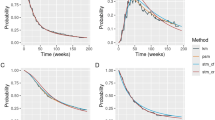Abstract
The application of clinical trial results to the management of the individual cancer patient is not always straightforward. The results of a clinical trial indicate the “average” effect of an intervention, often expressed in terms of an absolute risk reduction, which is an estimate of the likelihood of benefit for a particular patient. However, within any clinical trial, there might be differences between groups of patients in underlying pathology, genetics, or biology, and some patients might benefit more from a new treatment than others. Thus, within a clinical trial, it might also be useful to group together patients with similar characteristics, and test for subgroup interaction. The test for interaction will indicate whether the magnitude of benefit differs from one prognostic subgroup to the next (a quantitative interaction). Much less common are qualitative interactions, in which a new treatment is beneficial in one subgroup but harmful in another. If the test for subgroup interaction is significant, then the effects of treatment may indeed differ between subgroups of patients, but this should be confirmed in other trials before a treatment is implemented in clinical practice.

Similar content being viewed by others
References
Baum M, Houghton J. Contribution of randomized controlled trials to understanding and management of early breast cancer. Br Med J 1999;319:568–571
Mant D. Can randomized trials inform clinical decisions about individual patients? Lancet 1999;353:743–746
Pollack AV. Guidelines for the correct conduct of clinical research in surgery. Eur J Surg 1998;164:243–249
McMahon AD. Study control, violators, inclusion criteria and defining explanatory and pragmatic trials. Stat Med 2002;21:1365–1376
Helms PJ. “Real world” pragmatic clinical trials: what are they and what do they tell us? Pediatr Allergy Immunol 2002;13:4–9
Peto R, Baignent C. Trials: the next 50 years. Br Med J 1998;17:1170–1171
Senn S. Individual response to treatment: is it a valid assumption? Br Med J 2004;329:966–968
Tramer MR, Walder B. Number needed to treat (or harm). World J Surg 2005;29:576–581
Cook RJ, Sackett DL. The number needed to treat: a clinically useful measure of treatment effect. Br Med J 1995;310:452–454
Rothwell PM. Subgroup analysis in randomized controlled trials: importance, indications, and interpretation. Lancet 2005;365:176–186
Sackett Dl. Applying overviews and meta-analyses at the bedside. J Clin Epidemiol. 1995;48:61–70
Feinstein AR. The problem of cogent subgroups: a clinicostatistical tragedy. J Clin Epidemiol 1998;51:297–299
Peto R. Clinical trials. In Price P, Sikora K, editors, Treatment of Cancer, Chapter 52, New York, Chapman and Hall, 1995
ISIS-2 Collaborative Group. Randomized trial of intravenous streptokinase, oral aspirin, both, or neither among 17,187 cases of suspected acute myocardial infarction: ISIS-2. Lancet 1988;2:349–360
Yusuf S, Wittes J, Probstfield J, et al. Analysis and interpretation of treatment effects in subgroups of patients in randomized clinical trials. JAMA 1991;266:93–98
Lu M, Lyden PD, Brott TG, et al. Beyond subgroup analysis: improving the clinical interpretation of treatment effects in stroke research. J Neurosci Methods 2005;143:209–216
Assmann SF, Pocock SJ, Enos LE, et al. Subgroup analysis and other (mis)uses of baseline data in clinical trials. Lancet 2000;355:1064–1069
Gray R, Clarke M, Collins R, et al. The EBCTCG overview of adjuvant therapy for breast cancer. What are the implications for future studies? Early Breast Cancer Trialists’ Collaborative Group. Ann NY Acad Sci 1993;698:339–348
Early Breast Cancer Trialists’ Collaborative Group. Effects of adjuvant tamoxifen and of cytotoxic therapy on mortality in early breast cancer. An overview of 61 randomized trials among 28,896 women. N Engl J Med 1988;319:1681–1692
Early Breast Cancer Trialists’ Collaborative Group. Tamoxifen for early breast cancer: an overview of the randomized trials. Lancet 1998;351:1451–1467
Author information
Authors and Affiliations
Corresponding author
Additional information
The opinions and assertions contained in this article represent the private views of the authors and should not be construed as reflecting the official views of the U.S. Departments of the Army, Navy, or Defense, or the Department of Health and Human Services.
Rights and permissions
About this article
Cite this article
Jatoi, I., Proschan, M.A. Clinical Trial Results Applied to Management of the Individual Cancer Patient. World J. Surg. 30, 1184–1189 (2006). https://doi.org/10.1007/s00268-006-0073-x
Published:
Issue Date:
DOI: https://doi.org/10.1007/s00268-006-0073-x




